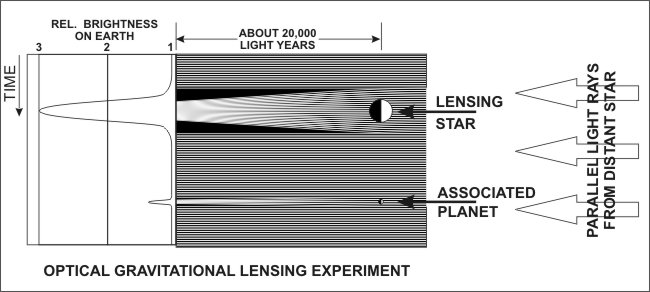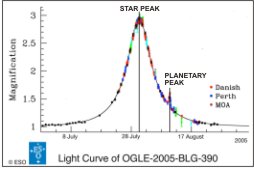


Ironical Chronicle Art Department
How gravitational lensing works
|
Some of our readers may have gotten the idea that we are trying to eclipse the New York Times. Without confirming or denying the idea, we simply point out that we operate with less than half the resources and at least twice the scruples of the flagship of the US propaganda flotilla.
Without further ado we present herewith our challenge to the Times' physics reporter, Dennis Overbye, who reports the achievements in that field like a housekeeper finding a dead mouse in her kitchen: She simply can't believe it.
The big story yesterday was the release of the information by the Europeans Southern Observatory that a planet (it has been named OGLE-2005-BLG-390Lb) about five times the mass of the Earth was discovered in orbit around a star about 20,000 light years from the Earth. This is really two stories rolled into one: The existence of such a small planet, which is not surprising, and the means by which it was detected, which is a stunning achievement, a further validation of Einstein's General Theory of Relativity, and a demonstration of a new tool in the search for exo-planets.
The new tool rests on the bending of light by a gravitational field, just as Einstein predicted it. The figure at the top of the page illustrates the phenomenon. The parallel rays of a distant star off to the right of the diagram pass through the gravitational fields of the lensing star and its companion planet, if it has one. These fields bend the parallel rays into two cones. The cone from the lensing star contains many more rays, a consequence of its much greater mass, than that of the planet cone. The curve of brightness on the left of the diagram represents the output of a photoelectric cell attached to a telescope on earth as the lensing star/planet system passes between the earth and the distant star. The time scale depends on the relative rates of motion of the three systems: the earth, the lensing star, and the distant star.

Ironical Chronicle/ESO |
Other details about the new planet are that it circles its parent star in about 10 years and has a surface temperature of -220°C (-364°F).
In the Times' view this makes it "akin" to the Earth and to Dennis Overbye, who is the Times' Rasputin in matters scientific, the marvelous science employed to detect it is "a trick of Einsteinian physics." That phrase appears in the second sentence of his review of the discovery. The first sentence, set off in its own paragraph, is, "Now you see it, now you don't." This is the language of amateur theatrics and cheap illusions which is reinforced in the next sentence by the "trick" reference.
In my opinion Overbye hates Einstein. If I'm right it puts him in with an odd assortment of "flat Earthers" and, even worse, Nazi "German physics" scientists like Philipp Lenard. The shared characteristic of anti-communism of these Nazis then makes Overbye a good fit at the New York Times.
OTTO

Now you see it, now you don't.
Astronomers say that by virtue of the ceaseless shifting of the billions of stars in the Milky Way and a trick of Einsteinian physics, they have briefly glimpsed the most Earth-like planet yet to be discovered outside the solar system. It is a ball of rock and ice only about 5.5 times as massive as Earth, smaller than any of the 160 previously discovered exoplanets, and is orbiting a dim reddish star 21,000 light-years from here.
The discovery, the researchers say, suggests that rock-ice planets like our own are predominant in the cosmos. That bodes well for future planet-hunting missions from space like the Terrestrial Planet Finders at NASA.
The distant planet manifested itself as a brief flash: As it passed at night in front of an even more distant star, its gravity focused and momentarily brightened the star's light.
It was all over in less than a day, a cosmic blink of an eye.
"It was the blip in the night that we have been waiting for," said Jean-Philippe Beaulieu of the Institut d'Astrophysique de Paris, who led an international collaboration of 73 astronomers. They reported their findings yesterday at a news conference in Washington and are publishing them today in the journal Nature.
Alan P. Boss, a planetary theorist at the Carnegie Institution of Washington, said in an e-mail message that the discovery was "a big one." Another expert who took no part in the research, Geoffrey W. Marcy of the University of California, Berkeley, said, "The result looks solid to me, and perhaps the planet is, too."
The planet, smaller than Neptune and dubbed OGLE-2005-BLG-390Lb, resides about 234 million miles from its star. At that distance, its surface temperature would be minus 370 degrees Fahrenheit, Dr. Beaulieu said.
The work was largely that of two large teams that have built far-flung observing networks to exploit a feature of Einstein's general theory of relativity. The theory says a massive object can act as a gravitational lens, bending and magnifying the light from more distant objects in space.
One team, the Optical Gravitational Lensing Experiment, or OGLE, led by Andrzej Udalski of Warsaw University, has been set up to monitor the brightness of millions of Milky Way stars every night from a telescope in Chile, so as to catch fluctuations caused by the passage of intervening objects of various kinds: dim stars, so-called dark matter objects or planets.
Last July, alerted by the OGLE team that such a lensing event was under way, Dr. Beaulieu's team, Planet (for Probing Lensing Anomalies NETwork), sprang into action to do high-resolution observations. On Aug. 9, that team recorded a tiny blip on a much larger blip that was caused by the passage of an unseen star, the planet's parent, in front of the more distant star. That tiny blip was the planet itself.
As Dr. Beaulieu explained in an e-mail message, it would have been much easier to see a giant gaseous type of planet. The long odds against detecting so small a planet as the new one argues for its commonness.
"If only a small fraction of the stars had such planets, we would have never detected this small planet," Dr. Beaulieu said.
Scott Tremaine, a theorist at Princeton, said, "The results suggest that rock-ice planets must be more common than gas giants."
Copyright 2006 The New York Times Company